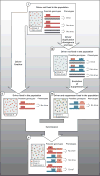Genetic Villains: Killer Meiotic Drivers
- PMID: 29499907
- PMCID: PMC5959745
- DOI: 10.1016/j.tig.2018.02.003
Genetic Villains: Killer Meiotic Drivers
Abstract
Unbiased allele transmission into progeny is a fundamental genetic concept canonized as Mendel's Law of Segregation. Not all alleles, however, abide by the law. Killer meiotic drivers are ultra-selfish DNA sequences that are transmitted into more than half (sometimes all) of the meiotic products generated by a heterozygote. As their name implies, these loci gain a transmission advantage in heterozygotes by destroying otherwise viable meiotic products that do not inherit the driver. We review and classify killer meiotic drive genes across a wide spectrum of eukaryotes. We discuss how analyses of these ultra-selfish genes can lead to greater insight into the mechanisms of gametogenesis and the causes of infertility.
Keywords: killer meiotic drivers; meiosis; meiotic drive; segregation distortion; selfish genes.
Copyright © 2018 Elsevier Ltd. All rights reserved.
Figures


References
-
- Sandler L, Novitski E. Meiotic Drive as an Evolutionary Force. The American Naturalist. 1957;91(857):105–110.
-
- Crow JF. Why is Mendelian segregation so exact? Bioessays. 1991;13(6):305–12. - PubMed
-
- Price TA, Wedell N. Selfish genetic elements and sexual selection: their impact on male fertility. Genetica. 2008;134(1):99–111. - PubMed
Publication types
MeSH terms
Grants and funding
LinkOut - more resources
Full Text Sources
Other Literature Sources
Research Materials

